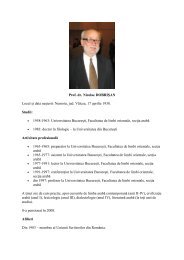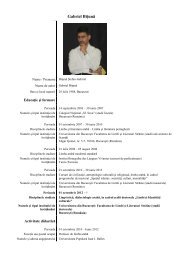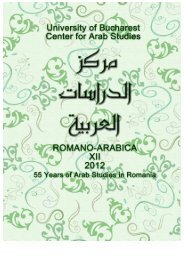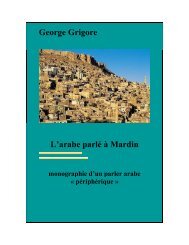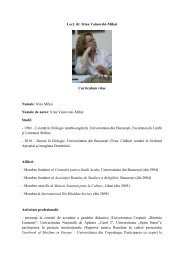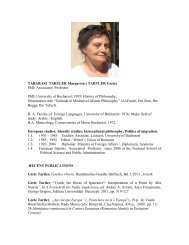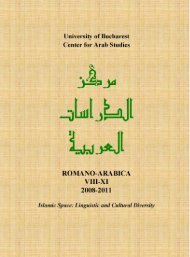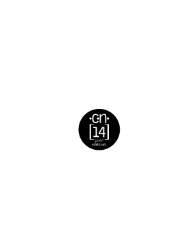- Page 1 and 2: University of Bucharest Center for
- Page 3 and 4: Editor: Nadia Anghelescu Associate
- Page 5 and 6: FOREWORD This issue of Romano-Arabi
- Page 7: əntu təktəbu But the dialects of
- Page 11 and 12: and was borrowed from standard Arab
- Page 13 and 14: . slip ‗to sleep‘ < E. sleep Th
- Page 15 and 16: (14) itnen dinar two dinar ‗two d
- Page 17 and 18: Ir. Ar. Finally, forms such as šwa
- Page 19 and 20: c. zen ‗good‘ and ‗well‘ Ca
- Page 21 and 22: (38) Tal hon baaden giv hada sikina
- Page 23 and 24: Similar cases are recorded in other
- Page 25 and 26: lexical hybrids + + lexical doublet
- Page 28 and 29: Some Peculiarities of Central Asian
- Page 30 and 31: dük ‗iyāl-ke kēyin ‗andun.
- Page 32 and 33: The plural form of ism in dialect d
- Page 34 and 35: Qahtan. It is known that southern A
- Page 36 and 37: Bible: ―But he rebelled against h
- Page 38 and 39: Shi‘ite Panegyrical Poems from th
- Page 40 and 41: Islamic Revolution in 1979, the nam
- Page 42 and 43: 3.1. The composer of the first poem
- Page 44 and 45: level within their community. 20 Th
- Page 46 and 47: poems from the age of 20 which were
- Page 48: sounds in many location names are i
- Page 51 and 52: nominale, mais aussi par un syntagm
- Page 53 and 54: Les énoncés attributif, locatif e
- Page 55 and 56: participe ou syntagme indéfini), q
- Page 57 and 58: Je ne suis pas fatigué. Le morphè
- Page 59 and 60:
y a », la particule d‘existence
- Page 62 and 63:
Where do we stand in the research o
- Page 64 and 65:
ǝʕtu bǝʕtu bǝḥtu bǝḥtu b
- Page 66 and 67:
Sasse 1971 on Mḥallami, Wittrich
- Page 68:
Talay, Shabo. 2001. ―Der arabisch
- Page 71 and 72:
groupe périphérique vivant aux co
- Page 73 and 74:
On n‘a pas retrouvé de textes si
- Page 75 and 76:
être mis en doute. Il n‘est pas
- Page 77 and 78:
le grec. On ajoutera que l‘origin
- Page 79 and 80:
sur ce qu‘on pourrait appeler la
- Page 81 and 82:
Caracausi, Girolamo, 1987-88. « I
- Page 83 and 84:
Sgroi, Salvatore Claudio. 1986. Int
- Page 85 and 86:
general), and greatly assisted by t
- Page 87 and 88:
The asymmetry in status in reflecte
- Page 89 and 90:
‘istat}a‗na ‘an nuh}aqqiq ha:
- Page 91 and 92:
Unequal status of variables as soci
- Page 93 and 94:
sociolinguistic context of the spee
- Page 96 and 97:
Grundvokabular und idiomatische Str
- Page 98 and 99:
haben, bei welchen semantischen Ber
- Page 100 and 101:
egelmäßig Hausa lernen, Hausa dag
- Page 102 and 103:
Die Auswertung der Basis-Wortliste
- Page 104 and 105:
Marokko, werden als Kontrollgruppe
- Page 106 and 107:
man von einer Koinisierung der Sema
- Page 108 and 109:
Does geographical periphery imply l
- Page 110 and 111:
elated dialect which represents the
- Page 112 and 113:
To facilitate comparative analysis
- Page 114 and 115:
see‖, which is perhaps of Armenia
- Page 116 and 117:
their Turkish compatriots, has resu
- Page 118 and 119:
Sasse, Hans-Jürgen. 1971. Linguist
- Page 120 and 121:
121 Table 1 B - Phonology I: Conson
- Page 122 and 123:
123 Table 2 - Phonology II: Vowels
- Page 124 and 125:
125 Table 3 A - Morphology I - Pers
- Page 126 and 127:
127 inside of ǧǝwwāt ǧōfāt
- Page 128 and 129:
129 G. Numerals a. Cardinal numbers
- Page 130 and 131:
131 Table 6 A - Lexicon: Syrian Gro
- Page 132 and 133:
Quelles nouvelles perspectives s’
- Page 134 and 135:
En 1977, dans un compte rendu propo
- Page 136 and 137:
la survie et la continuité du malt
- Page 138 and 139:
officiellement comme langue de l‘
- Page 140 and 141:
et le sujet fait l‘objet de contr
- Page 142 and 143:
l‘arabe : ana tərki ana, abūy k
- Page 144 and 145:
AIDA 5 th Conference Proceedings, C
- Page 146 and 147:
— 1995. « Towards a reassessment
- Page 148 and 149:
Beda u Qabad: The Maltese Inchoativ
- Page 150 and 151:
Bonaparte for:DET-Egypt that among
- Page 152 and 153:
high frequency of beda is a commona
- Page 154 and 155:
Madanakollu qbadna mexjin. all_the_
- Page 156 and 157:
What we do argue is that there is a
- Page 158 and 159:
Périphérie géographique et perm
- Page 160 and 161:
fois la question car toute donnée
- Page 162 and 163:
d‘entre eux n‘a eu qu‘un cont
- Page 164 and 165:
de langue officielle et employé à
- Page 166 and 167:
evolutionary ‗laws‘ and tendanc
- Page 168 and 169:
distribution complémentaires. Cela
- Page 170 and 171:
l‘ouest, d‘une part, et tous le
- Page 172 and 173:
le lien entre pronoms personnels et
- Page 174 and 175:
et « fille (de) » (cf. aġmah «
- Page 176 and 177:
Cohen, David. 1970. « Le système
- Page 178 and 179:
The influence of Turkish, Kurdish a
- Page 180 and 181:
čātəšma ―struggle‖ < Turk.
- Page 182 and 183:
of vowels. Actually, the vowels in
- Page 184 and 185:
sawa qārəšməš ―to intervene
- Page 186 and 187:
Grigore, George. 2000. ―Ku - un p
- Page 188 and 189:
Phonetic features and changes in An
- Page 190 and 191:
The volume of the samples has been
- Page 192 and 193:
the realizations /Ď/ > /t}/ > /t/
- Page 194 and 195:
above protetical graphemes - one of
- Page 196 and 197:
―confirm, support, assure‖, ‘
- Page 198 and 199:
ealization). The number of the root
- Page 200 and 201:
ġayn 0 _ 0 _ fā‘ 7 ft‘, fğ
- Page 202 and 203:
Corriente, Federico. 1995. Dīwān



